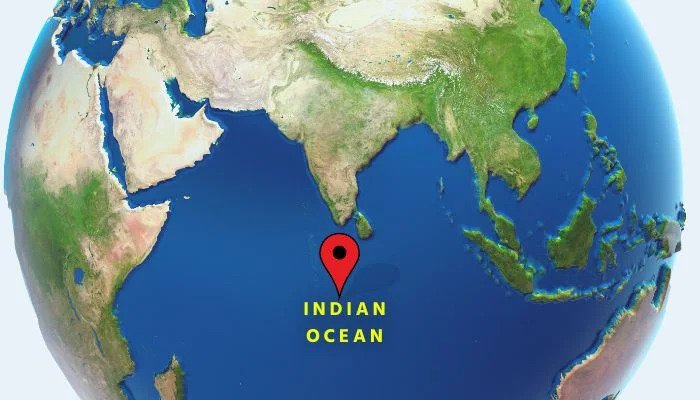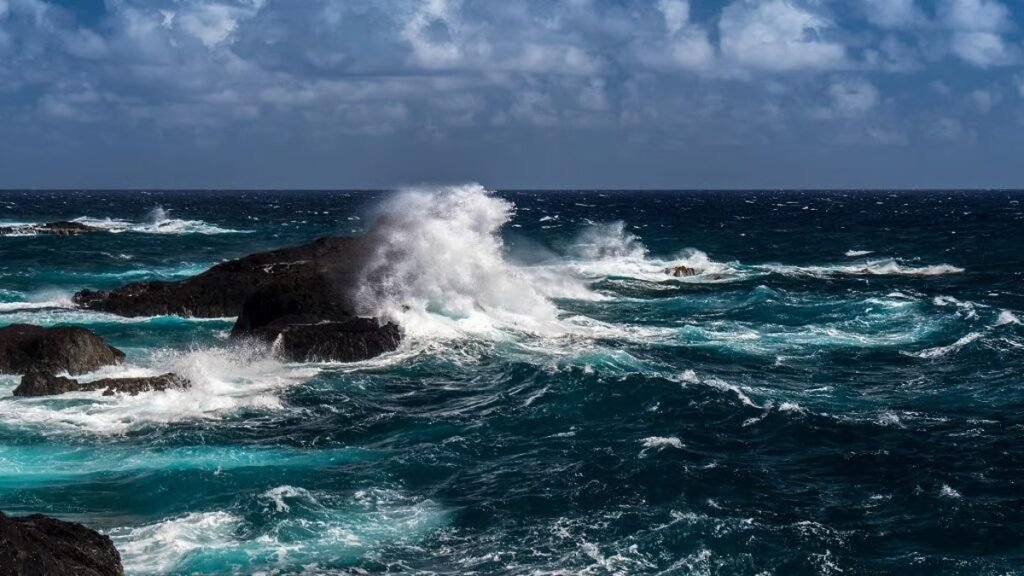Table of Contents
ToggleTop 10 Unknown and Fascinating Facts about the Indian Ocean
Asia to the north, Africa to the west, Australia to the east, and the Southern Ocean to the south encircle the Indian Ocean, which is the third-largest ocean in the world and an important body of water. With a surface area of around 70 million square kilometers, it is essential to marine biodiversity, global trade, and climate management.
Major economies in Asia, Africa, and Europe are connected by the Indian Ocean, which is an important trade route. It is home to important shipping routes like the Strait of Malacca and the Suez Canal, which are used to carry a large amount of the world’s cargo and oil. Tourism, fishing, and the availability of natural resources like gas and oil all depend on the water for coastal nations.

The monsoon system, which in turn affects South Asia’s and East Africa’s weather patterns, is greatly influenced by the ocean. Its warm seas absorb and disperse heat, which feeds cyclones and regulates the world’s temperature.
Rich marine biodiversity, including coral reefs, mangroves, and a variety of fish species, may be found in the Indian Ocean. Its waters provide habitats for whales, sharks, and dolphins, which makes it crucial for the conservation of marine life worldwide.
We will delve into ten obscure yet fascinating facts about the Indian Ocean in this blog post, covering its geography, history, ecology, and other topics. Let’s go out on this nautical adventure!
1. The Warmest Ocean on Earth
With an average temperature of almost 22°C (71.6°F), the Indian Ocean is the warmest ocean in the world. Its location, especially in tropical and subtropical climates, accounts for its warmth. Due to its limited exchanges with the colder waters of the Atlantic and Pacific Oceans, the region’s distinct climate dynamics add to the ocean’s heat.
The Indian Ocean’s warm temperature has a significant impact on Australia, Africa, and Asia’s weather patterns. Warm surface waters in South Asia stimulate the monsoon rains and aid in the development of tropical storms and cyclones in the area. Unlike other oceans, the Indian Ocean is never too cold or too hot during the seasons, and this constant warmth is essential to the development of the El Niño and La Niña phenomena.
Key Note: The warmer temperatures of the Indian Ocean also encourage faster growth of coral reefs, particularly in areas like the Maldives and Seychelles.
2. Home to the World’s Oldest Trade Routes
Some of the earliest trade routes in human history had their origins in the Indian Ocean. Ancient traders from Mesopotamia, Egypt, and the Indus Valley people sailed the waters of the Indian Ocean long before the European era of exploration. Ships could now sail from the Arabian Peninsula, India, and Africa to the Far East and back thanks to the discovery of monsoon winds, which completely changed trade.
For instance, the East African Swahili coast developed into a thriving center of trade, with traders trading spices, gold, and ivory. Due to the historical trading routes across the Indian Ocean, civilizations in areas like Arabia, Southeast Asia, and Africa were able to engage in significant cultural and commercial interchange. Since these historic routes still form the basis of contemporary shipping lanes, the Indian Ocean is essential to world trade.
Key Note: One of the earliest ports in history was located in the ancient city of Lothal, which was a part of the Indus Valley Civilization. This allowed for easier trade across the Indian Ocean.
3. The Unusual Underwater Volcanic Activity in the Indian Ocean
There is a zone of active geology beneath the Indian Ocean. Seamounts, or underwater volcanoes, and regions of tectonic activity are scattered across the ocean floor. The Carlsberg Ridge, an underwater mountain range where two tectonic plates converge, is one of the most prominent features. This ridge, which stretches from the Arabian Sea to the Indian Ocean, forms a region that is active seismically and volcanically.
A number of deep trenches, including the Sunda Trench, one of the world’s deepest locations, are located in the Indian Ocean. Over the years, the region’s strong seismic activity has caused a number of strong earthquakes and tsunamis, including the disastrous tsunami that struck the Indian Ocean in 2004.
Key Note: The Indian Ocean has had some of the biggest underwater eruptions in addition to tectonic activity, such as the 2018 eruption of the submarine volcano close to the French island of Mayotte.

4. A Marine Biodiversity Hotspot
Famous for its remarkable biodiversity, the Indian Ocean is especially rich in coral reef ecosystems that flourish in its shallow, warm waters. Bright coral reefs brimming with marine life, such as different varieties of fish, sea turtles, sharks, and rays, may be found in places like the Maldives, Seychelles, and Indonesia.
Some of the most significant marine ecosystems on Earth, like the Chagos Archipelago and the Great Barrier Reef of India (Gulf of Mannar), are sustained by the waters of the Indian Ocean. One of the world’s most biodiverse marine regions is the Indo-Pacific Region, which includes the Indian Ocean.
The coelacanth is a type of fish that is among the most fascinating marine animals in the Indian Ocean. It was believed to be extinct for millions of years until it was unearthed off the coast of South Africa in 1938.
Key Note: The largest fish in the world, the whale shark, may reach a length of 12 meters (40 feet) and is found in the Indian Ocean.
5. Piracy in the Indian Ocean: A Modern Problem
Even while it would appear to be a thing of the past, piracy is still a serious issue in some areas of the Indian Ocean, especially off the coast of Somalia. Commercial and fishing boats have been the targets of modern pirates, who frequently demand ransom in exchange for hostages. Increased international naval patrols and the formation of protective convoys for ships passing through the area are results of these acts of piracy.
One of the most hazardous regions for piracy is the Gulf of Aden, which is found in the northern section of the Indian Ocean. Nonetheless, during the past ten years, international initiatives have had some success in slowing the growth of piracy.
Key Note: Some pirates in the area locate and hijack vessels using cutting-edge technologies like GPS and satellite phones.
6. The “Garbage Patch” in the Indian Ocean
The Indian Ocean Garbage Patch, a significant concentration of plastic trash, affects the ocean similarly to the Pacific and Atlantic. Marine life is seriously threatened by this buildup of floating plastic garbage, which is a result of human activities and ocean currents. The patch lies in the area where ocean currents converge, known as the gyre, between Australia and Africa.
Small plastic particles and abandoned fishing nets are among the waste in the Indian Ocean Garbage Patch, which poses a risk to marine life that may consume the trash or become entangled in it. Although there are continuous efforts to clean up maritime rubbish patches, the process is difficult due to the size of the ocean and the extent of contamination.
Key Note: Every year, millions of seabirds and over 100,000 marine mammals perish in the Indian Ocean as a result of plastic garbage.
7. The World’s Largest Sand Desert Lies Beneath the Indian Ocean
Few people are aware that the “Grand Banks” or “Underwater Desert,” the largest underwater sand desert in the world, is located beneath the surface of the Indian Ocean. This enormous area of the ocean floor, which is mostly sand-covered and devoid of major flora, is located close to the continental shelves of Australia, Asia, and Africa.
Sand and silt from the continents are carried into the ocean by ocean currents, which is how this underwater desert is created. Despite having far less life than deep-sea ecosystems or coral reefs, the Grand Banks are essential to many marine processes, such as the deposition of sediment and cycling of nutrients.
Key Note: Several fish species and other bottom-dwelling animals like sea cucumbers depend on the Grand Banks for their vital habitat.

8. Birthplace of the Deadliest Tsunami
One of the deadliest natural disasters in recorded history has its epicenter in the Indian Ocean. Massive underwater seismic activity off the Indonesian coast of Sumatra on December 26, 2004, set off a chain of tsunamis that ravaged coastal regions in fourteen nations, including Thailand, India, Sri Lanka, and Indonesia.
Over 230,000 people lost their lives and millions more were affected as a result of the Indian Ocean tsunami. In the years that followed the tragedy, it also brought attention to the Indian Ocean region’s deficiency of an efficient early-warning system, which encouraged international attempts to build improved monitoring and disaster response capabilities.
Key Note: With waves that in some locations reached heights of up to 30 meters (100 feet), the 2004 tsunami is among the worst in recorded history.
9. The Indian Ocean has no Indigenous Islands.
The islands of the Indian Ocean were once uninhabited, in contrast to the Pacific Ocean, which has many islands that are home to indigenous inhabitants (such as Polynesia, Micronesia, and Melanesia). Following their discovery by explorers or traders, human communities eventually established on islands such as the Maldives, Seychelles, and Mauritius.
Arab, Portuguese, Dutch, and British colonial powers were among the explorers who made these islands into significant trading hubs and travel destinations. The Indian Ocean islands, which are now mostly inhabited by the offspring of colonists and migrants from the colonial era, are exceptional in that they lack indigenous inhabitants.
Key Note: A lot of the islands in the Indian Ocean still have a high biodiversity, particularly indigenous species of birds, plants, and reptiles that are unique to their region.
10. A Mystery of the Indian Ocean: Flight MH370
Malaysia Airlines Flight MH370, which was traveling from Kuala Lumpur to Beijing on March 8, 2014, vanished over the Indian Ocean, raising one of the biggest aviation mysteries of the twenty-first century. Only a few bits of debris have been found, and the airplane has never been fully recovered despite intensive search efforts.
There are a lot of theories and conjectures regarding what could have happened when MH370 vanished. Nevertheless, the precise location of the wreckage and the reason behind the plane’s disappearance are still a mystery.
Key Note: With over 120,000 square kilometers of ocean searched, the search for Flight MH370 was one of the most costly and largest search operations in history.
Despite being the least understood ocean in the world, the Indian Ocean is brimming with fascinating information, unanswered questions, and prospects. It is an essential component of the natural and geopolitical fabric of our world because of its warm waters, abundant biodiversity, and historical significance. The Indian Ocean continues to be one of the most fascinating regions of the natural world as we go deeper and attempt to unravel its mysteries.

